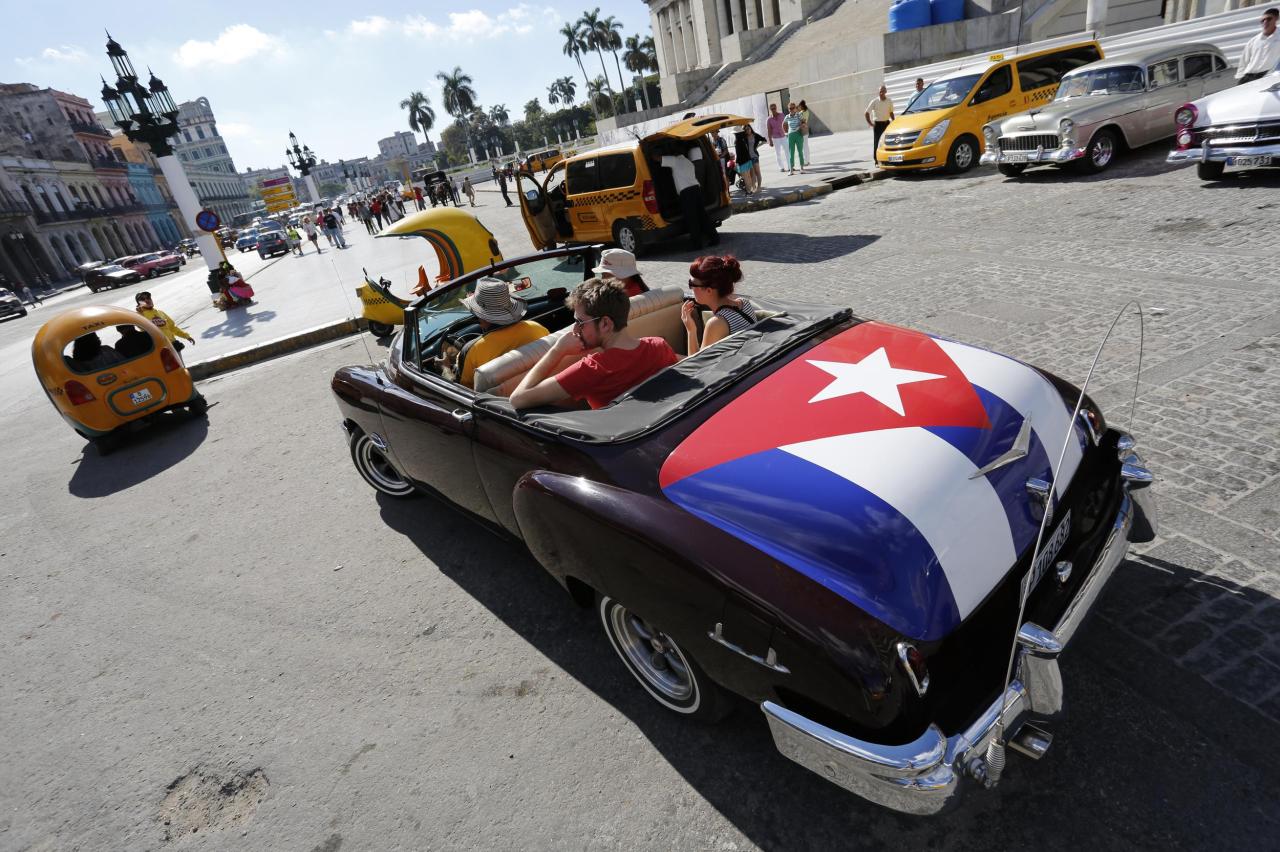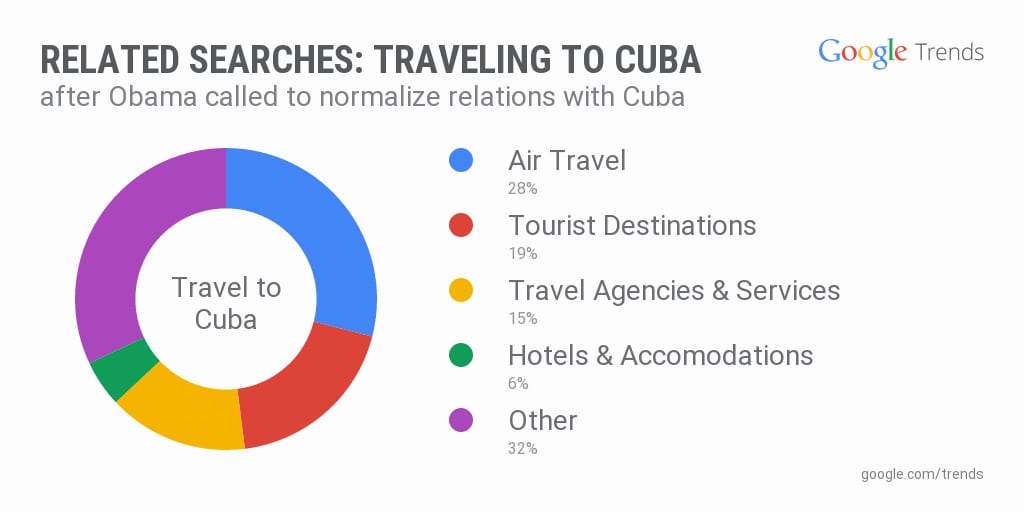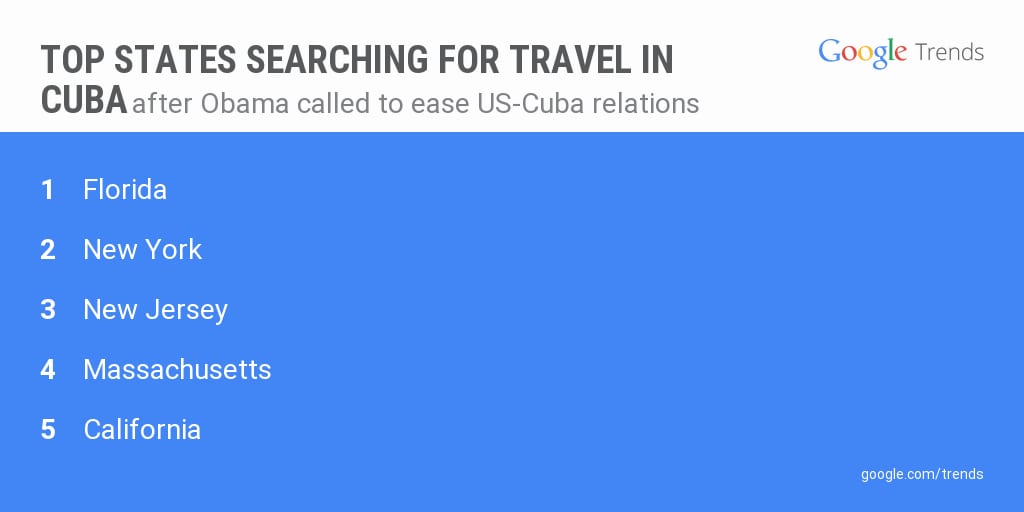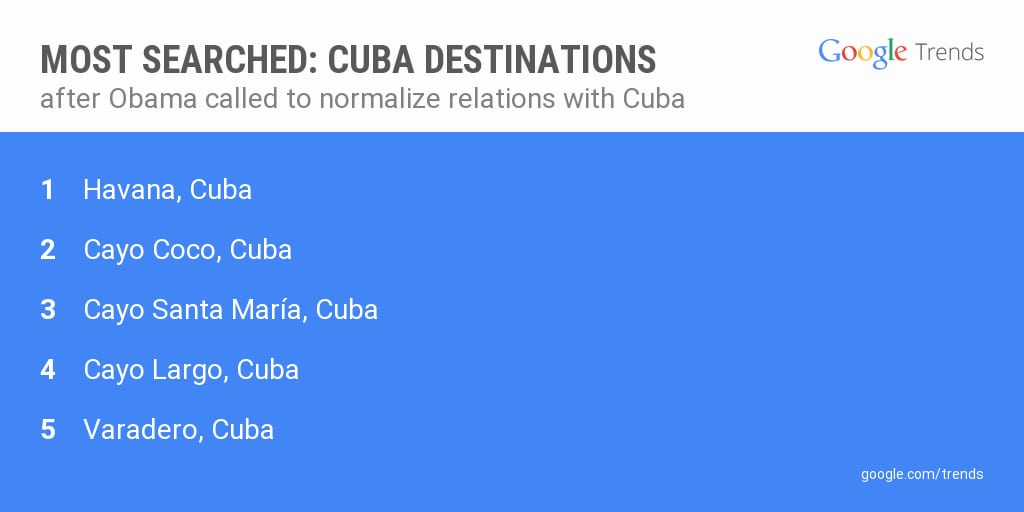Skift Take
No surprises here: there's still American interest in Cuba and U.S. travelers will begin trickling into the island more than ever before, but it doesn't look like we'll see the pressure hose turned on any time soon.
Americans now have fewer barriers to a trip to Cuba, but according to search data and surveys from multiple companies this has failed to spark a surge of interest in vacations on the island.
Other Caribbean islands can rest easy — at least for now — as travel data about online searches has not revealed lost market share to Cuba.
American travelers showed higher than average interest in Cuba after the Obama administration announced in December a thaw in relations that included reestablishing the American Embassy in Havana. Obama then relaxed the American travel ban in January, which drove another small uptick in interest.
But the upswing in Americans’ curiosity about traveling to Cuba was not sustained. This is not necessarily surprising at this point because there has been neither a significant increase in the number of direct flights available (with few exceptions), nor a new, easy way to book travel or hotels online.
An MMGY U.S. survey conducted between January 22 to 29 found 19% of respondents would consider a Cuban vacation during the next two years. Millennials (27%) had the highest percentage of favorable responses to a Cuba vacation followed by Generation Xers (24%). Whether that number is encouraging news for tour operators and airlines working to establish tours and service to the island remains to be seen.
On a more encouraging note, MMGY’s survey also found 46% of respondents would be willing to change their vacation plans to visit Cuba instead of another destination in the Caribbean during the next two years (14% said they wouldn’t change plans).
The Status of America’s Cuba Search Volumes
Cuba wasn’t at the top of the leaderboard for most-searched Caribbean islands for travel before Obama’s December announcement and in the months since it has slightly improved its position.
Puerto Rico held the top spot for the Caribbean island with the highest American search volumes prior to December 17, 2014, the day before Obama’s announcement, and it still claims that spot, according to Sojern, a travel data and advertising company. At the end of January, Cuba was the 16th most popular Caribbean island Americans searched for out of the 20 islands Sojern considered for its ranking, and Cuba held the 19th spot before the announcement.
Most Popular Caribbean Islands for American Search Volumes
| Rank | Prior to December 17, 2014 | End of January 2015 |
|---|---|---|
| 1 | Puerto Rico | Puerto Rico |
| 2 | Dominican Republic | Dominican Republic |
| 3 | Jamaica | Jamaica |
| 4 | US Virgin Islands | US Virgin Islands |
| 5 | Bahamas | Bahamas |
| 6 | Aruba | Aruba |
| 7 | Sint Maarten | Sint Maarten |
| 8 | Haiti | Turks and Caicos |
| 9 | Turks and Caicos | Cayman Islands |
| 10 | Cayman Islands | Saint Lucia |
| 11 | Trinidad and Tobago | Trinidad and Tobago |
| 12 | Saint Lucia | Haiti |
| 13 | Barbados | Barbados |
| 14 | Antigua and Barbuda | Antigua and Barbuda |
| 15 | Curacao | Curacao |
| 16 | Saint Kitts | Cuba |
| 17 | British Virgin Islands | British Virgin Islands |
| 18 | Grenada | Grenada |
| 19 | Cuba | Saint Kitts |
| 20 | Dominica | Dominica |
Source: Sojern
Where is American Interest in Cuba Coming From?
Online travel agency CheapAir.com announced February 26 it would begin selling flights to Cuba from the U.S. CheapAir states it had more than 10,000 searches that day for flights to Cuba from U.S. cities and unsurprisingly most of the searches came from travelers looking to book flights from Miami International Airport, the closest major U.S. gateway to Cuba (16% of the searches) followed by New York City area airports (13.5%) and Los Angeles International Airport (7%).
CheapAir isn’t doing something Americans can’t already do themselves as flying direct to Cuba via commercial flights from the U.S. still isn’t possible with the trade embargo still in place. The site instead aims to make it easier for U.S. travelers to book connecting flights via primarily Mexican or Canadian airports.
CheapAir CEO Jeff Klee told Skift his site uses Mexican airports the most for connecting flights from the U.S. to Cuba and that “in the next one to two weeks our searches will get smarter with more connecting point options.” CheapAir’s Cuba search tool broke shortly after launch, which the company blamed on higher than anticipated interest.
Some 2.85 million travelers visited Cuba in 2013 with Canada accounting for 39% (1.1 million) of those travelers, the largest percentage, airline data firm OAG found in its report on how American travel interest in Cuba may change over time. The U.S. and Mexico each accounted for only 3% of visitors to Cuba and the U.K., France, Germany, Spain, and Italy each accounted for 5% or less of visitors.
More than 715,000 U.S. travelers took one-way charter flights in 2013 between the U.S. and Cuba and OAG estimates the current demand is 400,000 U.S.-originating passengers each way to and from Cuba, adding that the bulk of this demand comes from Cuban Americans wanting to visit friends and relatives.
Last year, about 18,000 commercial air passengers traveled between the U.S. and Cuba, the majority departing from Miami International Airport and connecting through Nassau, Bahamas, and Grand Cayman, OAG found.
What Google Says About Cuba Searches
Google furnished the following charts to Skift illustrating American interest in terms of search volumes for Cuba, with the first chart showing that air travel accounts for 28% of Cuba-related searches and hotels and accommodations in Cuba make-up only 6% of these searches.
The next two charts highlight searches from which U.S. states show the most interest in Cuba and what Cuban cities Americans searched for the most since December.
The last chart depicts near-flatlined American interest in Cuba since the December announcement in terms of Google searches.
This collection of data prove there is still some interest in American travel to Cuba and don’t offer too many surprises we hadn’t already predicted. MMGY’s finding of 46% of respondents saying they would alter their Caribbean travel plans in favor of a Cuba trip bodes well for the island’s future tourism prospects assuming Congress will make moves to abolish the trade embargo. Until that happens, how much interest Cuba will sustain with U.S. travelers moving forward remains unknown.
U.S. Search Volume Index for “Cuba” During Past 90 Days
Note: the last chart shows U.S. search volumes for Cuba relative to the popularity of all search terms searched for in the U.S., with 100 being the index’s highest possible value.
Source: Google Trends
The Daily Newsletter
Our daily coverage of the global travel industry. Written by editors and analysts from across Skift’s brands.
Have a confidential tip for Skift? Get in touch
Tags: cuba, google, mmgy, sojern
Photo credit: Tourists take a ride in a classic American convertible car with the Cuban national flag painted on the trunk, in Havana, Cuba. Desmond Boylan / Associated Press



